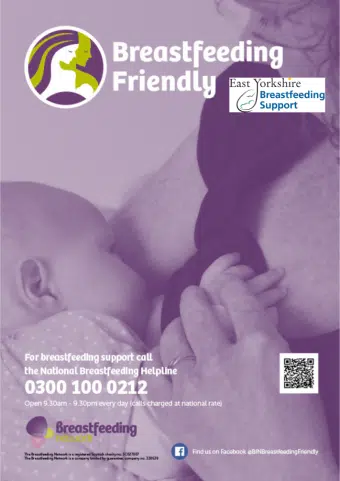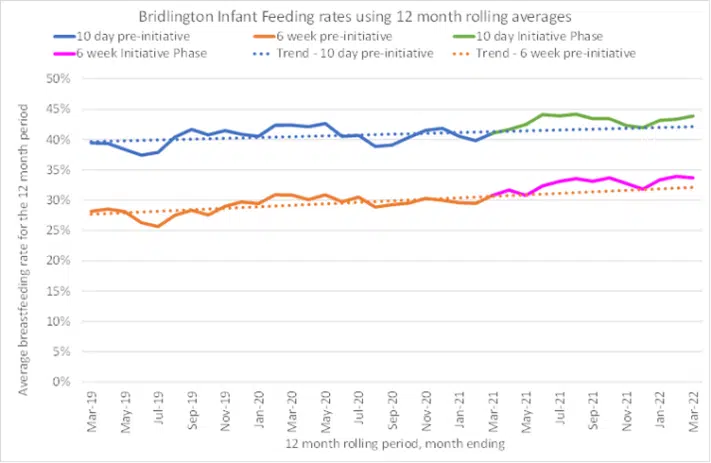20th January 2023
We are delighted to share this Voices blog by Sarah Clapham, FNP Supervisor / Modern Matron at Humber Teaching NHS Foundation Trust. This iHV Voices blog presents a whole community, multi-agency project to improve breastfeeding rates, using data and local intelligence to remove barriers and drive change.

The Bridlington breastfeeding project commenced in January 2021 and was rooted in enabling community recovery from the impacts of the COVID-19 pandemic. The number of mothers breastfeeding in Bridlington was low in comparison to other areas in East Yorkshire. The aim of the project was to understand and remove some of the barriers towards breastfeeding, by increasing the number of mothers who felt able to breastfeed for as long as they wished to and promote Bridlington as a breastfeeding friendly town.
The project was a collaboration between Humber Teaching NHS Foundation Trust Integrated Specialist Public Health Nursing Service (ISPHNS) and East Yorkshire Council Children’s Centres, who worked closely with local maternity services. The ISPHN service co-ordinated the project, financially supported by Humber Coast and Vale Maternity Services and East Riding of Yorkshire Council. The project focused on ensuring that breastfeeding mothers in Bridlington felt supported and comfortable breastfeeding in the community.
To increase the initiation of breastfeeding, local maternity services promoted colostrum harvesting at 36-week midwifery appointments and an early referral pathway from midwifery to the ISPHN specialist breastfeeding service (run by trained or trainee lactation consultants) was established to optimise support around attachment and positioning.
The Breastfeeding Networks ‘Breastfeeding friendly town’ scheme was utilised in conjunction with the launch of a local breastfeeding support webpage which brought together breastfeeding support options within the local area.
The Bridlington health visiting team were integral to the project’s success, as the service has universal reach and works with all families with babies in the town. The health visiting team contacted parents six days after the birth of their baby to determine a parent’s chosen feeding method and, where applicable, a breastfeeding assessment was completed. Most families in England will see a health visitor between 10 and 14 days after the birth of their baby, in line with the national health visitor service model. This additional early contact was introduced in Bridlington to improve the earlier identification of any breastfeeding problems and ensure that additional support was provided where this was needed. This strategy and referral processes resulted in either extra health visiting or children centre breastfeeding support visits, an earlier health visitor new birth visit, or a referral into the specialist breastfeeding service.
The children centre infant feeding champions, whose role was to sign up local businesses to the ‘Breastfeeding Friendly Town’ scheme, tirelessly walked the streets of Bridlington discussing the merits of breastfeeding and the need to support breastfeeding families to local businesses. The infant feeding champions recruited 100 local businesses including local cafes, pharmacies, GP surgeries, libraries, and restaurants.
Iain Garner, owner of Ruby SoHo Café, Bridlington, said:
“I signed up to the scheme straight away as breastfeeding is promoting the health of future generations and I want the mums and families who visit my café to feel 100% comfortable when Mum needs to breastfeed. I already have a changing area for families and so this scheme was perfect in expanding the family environment I already provide to my customers”.
This quote was utilised in a public relations campaign that involved radio and television interviews with the project’s team and local businesses.
The project used data to demonstrate impact. For the purposes of quantitative analysis, the project team was able to share data sets from maternity and the ISPHN service to provide a baseline for breastfeeding initiation rates. Breastfeeding rates (full and partial breastfeeding) are highly volatile and subject to large changes month on month, making it difficult to identify trends and initiative impacts over a short time interval. To address this, the project team used 12-month averages of aggregate data to track changes and provide a comparison of pre- and post-initiative breastfeeding rates. This was collected and analysed at two separate time points when babies were 10-days and 6-weeks old.
Table 1: ISPHN Data

In Table 1, the trend line for the ’10-day pre-initiative’ (baby at 10-days old) breastfeeding rate was calculated up to March 2021 and forecasted to March 2022. If breastfeeding rates had continued in line with the pre-initiative period forecast, we would expect an even distribution of data points both above and below the trend line. However, following the initiative, all the data points for the Initiative Phase consistently exceeded the forecasted trend line, clearly showing a positive change in breastfeeding rates during this period.
The same impact can be seen at 6 weeks (baby at 6-weeks old), with the Initiative Phase above the 3 of 4 projected trend from the pre-initiative phase. At six weeks, Bridlington was already improving at a faster rate that the rest of the region (dotted orange line is steeper than the dotted red line), and this improvement accelerated during the initiative, during which the pink line is consistently above the projected trend, i.e., above the expected average.
Table 2: ISPHN Data

The Table 2 ISPHN data graph illustrates the ERY average rate (12 months rolling) excluding Bridlington. The ERY-wide (excluding Bridlington) lines are shown using a different scale (right hand vertical axis) so that they overlap, making it easier to compare. The Bridlington figures still refer to the left-hand vertical axis.
The graph clearly shows that the 10-day rate was changing in line with the rest of the region until the initiative, at which point the green line is consistently above the projected trend.
Although the available evidence is positive, the project team recognised that there were shortcomings in the available data in demonstrating the level of improvement. It was recognised early on that the numbers were small for statistical purposes which is why the analytical approach detailed above was used as a means to present the trend data more clearly.
The project team utilised Insight funding to better understand the barriers to breastfeeding in the Bridlington population using qualitative data. These were collected by conducting a workshop with new mothers that was facilitated by an independent researcher, to promote open conversations about feeding, and underpinned by a quantitative online survey. The preliminary findings suggest that breastfeeding mothers felt that they were judged by bottle feeding mothers. There is a longstanding ‘culture’ of bottle feeding in Bridlington and this is seen as the norm that needs to be addressed through an increased focus on educating grandparents and partners about the ways that they can support breastfeeding and its benefits.
As part of the project, breastfeeding books were issued to libraries and early years settings to begin to normalise breastfeeding, and therefore better influence future generations and create a culture of breastfeeding in Bridlington. Further learning from the project identified that newly breastfeeding mothers preferred support that reached out to assist them to breastfeed in the community rather than expecting them to attend sessions at the children’s centres. To address this, there is a need to increase the number of support venues in the community rather than offering internal drop-in sessions.
The project outcomes were so successful that the local authority has agreed to fund further initiatives over the next 12 months, using the same project management model.
The success of our grass root collaboration would be further enhanced if it was coupled with long-term government policy that supports breastfeeding and puts the people who use services very much at the centre of their care and the long term plans for the health and care system.

